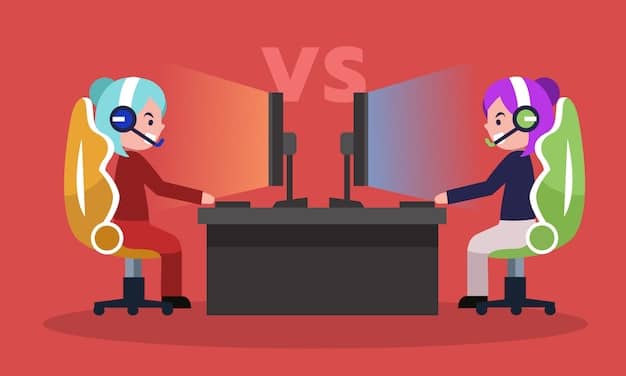The Psychology of Skins: How Your Skin Choice Affects Your Opponent’s Mindset

The psychology of skins in gaming reveals how a player’s choice of cosmetic items influences their opponent’s mindset, affecting perceptions of skill, confidence, and even intimidation, ultimately shaping in-game interactions and strategies.
Skins are more than just cosmetic enhancements in video games; they’re powerful psychological tools. Understanding the psychology of skins: how your skin choice affects your opponent’s mindset can give you a competitive edge.
Understanding the Basics of Skin Psychology
Skins in video games have evolved from simple visual customizations to complex expressions of identity and status. This section explores the core principles behind how skin choices impact player psychology and influence in-game dynamics.
The Visual Impact of Skins
Skins provide a direct visual cue to other players, immediately conveying information about the wearer before any actual gameplay occurs. A visually striking or rare skin can signal experience and investment in the game.
Status and Rarity
Rare or expensive skins often indicate a player’s status within the game community. These skins can be seen as a display of wealth, dedication, or skill in obtaining them through challenging in-game achievements.

The psychology of skins is also tied closely to a feeling of exclusivity. Imagine seeing someone sporting a skin that you know is incredibly hard to get. It’s natural to assume they’ve put in a lot of work to achieve that level. This could cause intimidation.
- Visual prominence enhances perceived skill.
- Rarity creates a perception of higher status.
- The combination can lead to psychological advantages.
In essence, the psychology of skins is about leveraging visual cues to influence perceptions and gain a mental edge in the game.
The Intimidation Factor: How Skins Can Scare Opponents
One of the most potent effects of skin choice is the ability to intimidate opponents. A well-chosen skin can instill fear and uncertainty, causing opponents to make mistakes or hesitate in crucial moments.
Projecting Confidence
Players often associate elaborate or highly-regarded skins with skill, leading opponents to believe they are facing a formidable adversary. This can subtly shift the balance of power even before the match begins.
Creating Uncertainty
A unique or unexpected skin can throw opponents off balance, forcing them to second-guess their strategies. This disruption can be especially effective in competitive scenarios where quick decisions are critical.

In the competitive world of esports, where every advantage counts, some pro gamers understand the psychology of skins: how your skin choice affects your opponent’s mindset and utilize them as psychological warfare. While skill is important, the way you present yourself matters too.
- Elaborate skins project confidence.
- Unexpected skins create uncertainty.
- Intimidation leads to mistakes.
By carefully selecting skins that project competence and disrupt expectations, players can gain a significant psychological advantage over their opponents, potentially turning the tide of battle in their favor.
Signaling Skill and Experience
Skins are often used to signal a player’s level of skill and experience within a game. This signaling can influence how opponents perceive and interact with the player, creating both opportunities and challenges.
The “Smurf Skin” Strategy
Some players intentionally use default or basic skins to appear less experienced than they actually are. This tactic, known as “smurfing,” can lower opponents’ guard, leading to easier victories.
The “Pro Skin” Effect
Conversely, players may choose high-end or exclusive skins to announce their expertise, hoping to intimidate opponents and secure favorable match-ups. However, this can also attract unwanted attention from skilled players looking for a challenge.
The ability to convey a sense of skill or experience through skin choice is a crucial element of the psychology of skins: how your skin choice affects your opponent’s mindset. Understanding potential misdirection is essential.
Analyzing Opponent Skin Choices
Paying attention to an opponent’s skin choice can provide valuable insights into their mindset and potential skill level. While not always accurate, this information can inform strategic decisions and tactical adjustments.
Ultimately, using skins to signal skill and experience is a double-edged sword; it can attract attention while potentially setting up interesting tactical plays. It is up to the user to decide what is best, based on their gameplay strategy.
The Role of Customization in Self-Expression
Beyond intimidation and signaling, skins play a significant role in allowing players to express their individuality and creativity within the game world.
Personal Identity
Choosing a skin that resonates with one’s personal style, interests, or values can enhance the sense of immersion and connection to the game. This personal touch can also foster a sense of pride and ownership in one’s in-game persona.
Community Identity
Skins can also serve as a form of community identity, allowing players to align themselves with specific groups, factions, or subcultures within the game. This can strengthen social bonds and create a sense of belonging.
The Art of the Combo
Many games allow players to combine skins with other cosmetic items, such as emotes, sprays, or weapon attachments, to create unique and personalized loadouts. This “combo” approach allows for even greater self-expression and creativity.
The psychology of skins is also about identity, since players often project their persona and beliefs onto their digital avatars. By using customization options, gamers can showcase a sense of style, beliefs, or even current interests, which can have both intended and unintended implications.
Skins allow players to showcase their digital persona, connect deeper to the game or community, or simply express who they are as people.
Cultural and Social Influences on Skin Preferences
Skin preferences are often influenced by cultural and social factors, reflecting broader trends and values within the gaming community and beyond.
Trending Skins
Certain skins become popular due to their association with trending memes, viral videos, or popular streamers. These “trending” skins can quickly gain traction, becoming status symbols in their own right.
Collaborations and Crossovers
Many games feature collaborations with popular brands, movies, or celebrities, resulting in unique skins and cosmetic items. These collaborations can introduce new audiences to the game and create buzz around the skin community.
The cultural and social dimensions of the psychology of skins: how your skin choice affects your opponent’s mindset should not be ignored. Being aware of those trends enables strategic usage in various contexts.
Regional Differences
Skin preferences can also vary by region, reflecting local cultural norms and values. For example, skins featuring traditional clothing or folklore may be more popular in certain areas.
- Trending skins reflect broader cultural trends.
- Collaborations introduce new audiences.
- Regional differences showcase cultural specifics.
The way skins are chosen is often a mirror of broader cultural patterns and how players engage with the game.
Ethical Considerations: Pay-to-Win vs. Cosmetic Only
The monetization of skins and other cosmetic items raises ethical considerations, particularly regarding the distinction between “pay-to-win” and purely cosmetic enhancements. Games are often very clear about cosmetic changes, but this is not always the case.
The Controversy of Pay-to-Win
Some games offer skins or items that provide tangible gameplay advantages, such as increasedStatsor enhanced abilities. This “pay-to-win” model is often criticized for creating an uneven playing field and undermining the principles of fair competition.
The Value of “Cosmetic Only”
Most ethical game developers prioritize “cosmetic only” monetization, ensuring that skins and items do not provide any competitive advantage. This approach respects the integrity of the game while still allowing players to support the developers and express their individuality.
It is crucial to recognize the ethical implications of the psychology of skins: how your skin choice affects your opponent’s mindset and the monetization techniques employed by game creators.
Ultimately, the ethical considerations surrounding skin monetization are a complex and ongoing debate. Hopefully, the ongoing discussions will lead to the most ethical and enjoyable outcomes for game designers and players, alike.
| Key Point | Brief Description |
|---|---|
| 💪 Intimidation Factor | Using elaborate or rare skins can intimidate opponents, making them more prone to mistakes. |
| 🎭 Self-Expression | Skins enable players to express their individuality through visual customization. |
| 🌐 Cultural Influences | Cultural and social trends heavily influence the popularity and perception of skins. |
| ⚖️ Ethical Considerations | The monetization of skins should prioritize cosmetic-only enhancements to ensure fair gameplay. |
FAQ
▼
Skins primarily affect the psychological aspect of gameplay. They can intimidate opponents, signal skill level, or provide a sense of confidence. They do not directly alter gameplay mechanics unless a game uses “pay-to-win” models.
▼
Not necessarily. While expensive or rare skins can indicate dedication or experience, they don’t guarantee skill. Some players acquire skins through trading or purchasing, rather than earning them through gameplay.
▼
Yes, it can. Some players use default skins to appear less skilled, leading opponents to underestimate them. This can create opportunities to surprise and outplay opponents who might otherwise be more cautious.
▼
Cultural trends play a significant role in skin popularity. Skins associated with trending memes, popular streamers, or cultural events often become status symbols, reflecting broader trends within the gaming community.
▼
The “pay-to-win” debate centers on whether skins or items should provide gameplay advantages. Critics argue that such systems create an uneven playing field, while proponents claim it supports game development. “Cosmetic-only” models are generally considered more ethical.
Conclusion
In conclusion, the psychology of skins in gaming is a multifaceted topic that delves into how visual customization impacts player perception, behavior, and strategy. Understanding these psychological dynamics gives players strategic advantages, allows deeper self-expression, and offers insights into broader cultural and ethical dimensions within the gaming world.





